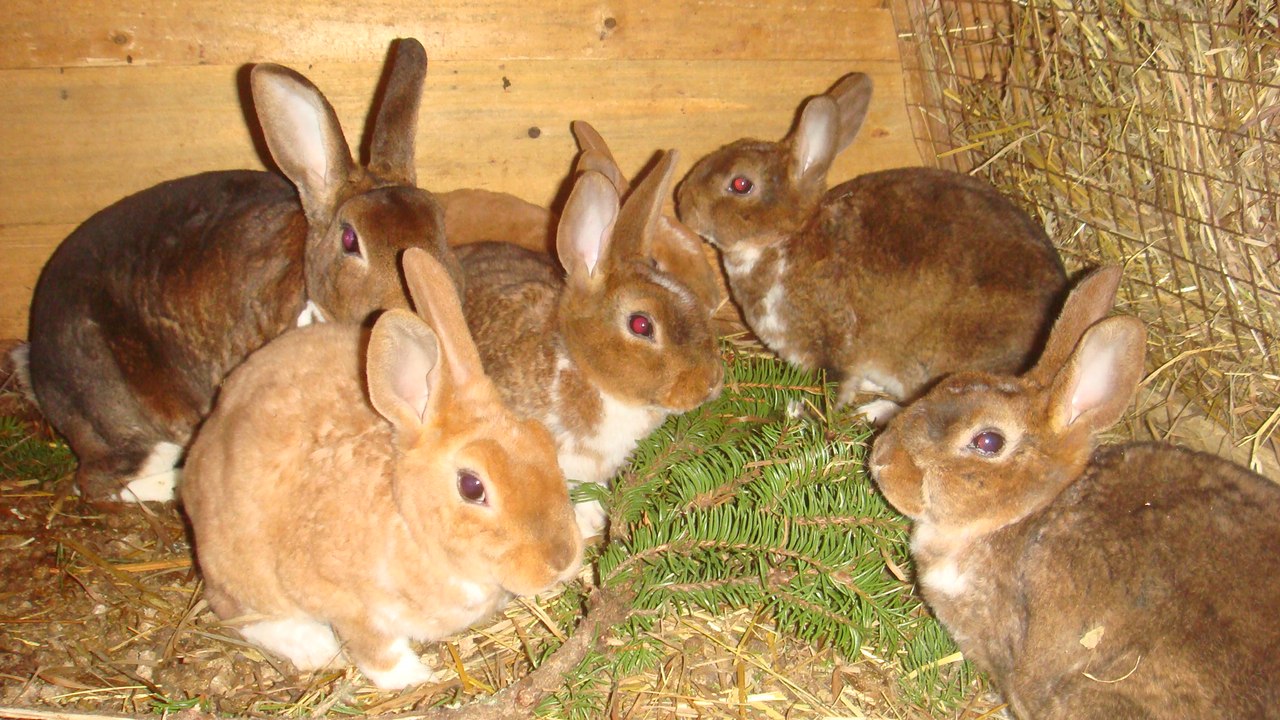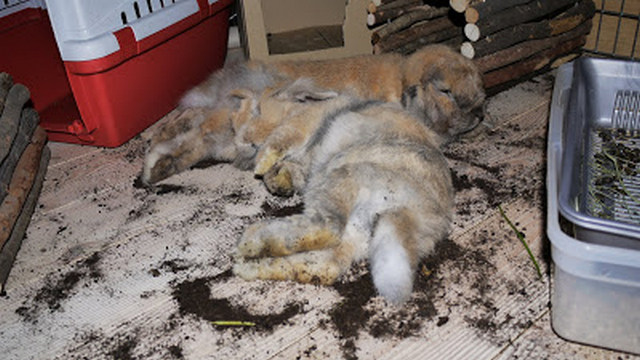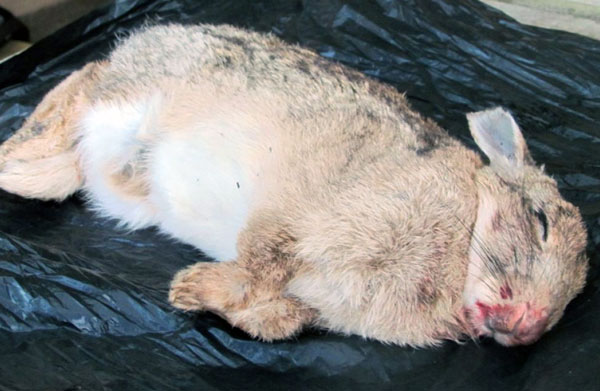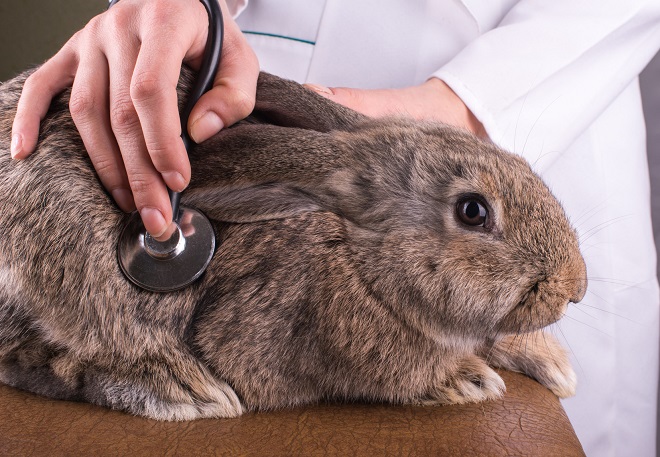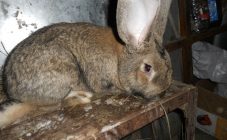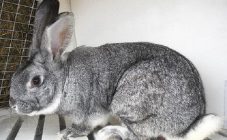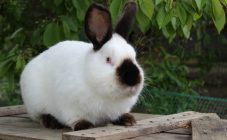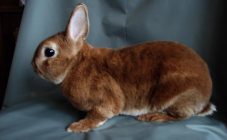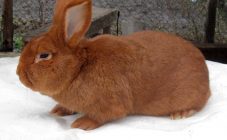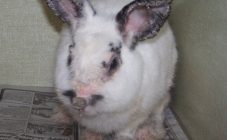Content:
Rabbits may have a lack of appetite for a variety of reasons. Disorders of the digestive processes can lead to the development of systemic diseases.
Causes of indigestion
Rabbit doesn't eat or drink what to do? One of the common causes is animal stress. When transporting a rabbit to a new location, there may be a lack of appetite. At this time, the rabbit does not eat anything and sits in one place. The bunny will refuse food and water, try to sit in a secluded place until the adaptation period to new conditions has passed. Once the animal adapts, its interest in food and drink will reappear.
The next factor is the formation of a ball of wool in the stomach of the individual. In the process of washing, the hair of the animal itself enters the gastrointestinal tract. With a normally functioning digestive system, wool is excreted in the feces. However, during the period of active shedding, wool accumulates in the stomach, forming a dense lump. You can identify such a formation by observing the animal:
- the weakness of the individual;
- difficulty of movement;
- firmness and pain on palpation of the abdomen;
- connection of individual peas of feces with a thread.
Why can excessive fur build-up occur? An unbalanced diet can act as a provocateur for the formation of a wool ball. When feeding rabbits with the same type of food, animals will try to independently compensate for the deficiency of substances by eating their own wool.
What if the rabbit stops eating and drinking? Incorrectly formed teeth in length can be the next reason for refusal to feed. The formation of hooks on the teeth of rabbits is called malocusia. Trying to drink or eat, an animal with such a disease will injure itself and ultimately refuse to eat, it will lose weight before our eyes. In this case, an operation is required to bring the teeth into proper condition.
If the rabbit lies on its side does not stand up, barely breathes, then this may be a sign of an infectious process. Infection with certain pathogens can affect the ability of rabbits to feed. Only a specialist will help to identify the cause of an infectious disease.
Colibacillosis, a serious illness transmitted by E. coli, has similar signs of refusal to eat. However, it is possible to identify the pathogen only by making a feces analysis. Without appropriate treatment, the death of an infected rabbit is possible 3-7 days after the first signs appear.
In addition to all of the above, catarrh can be the cause of the development of gastrointestinal pathologies. There are 3 types of catarrh: alkaline, sour and cold. In any case, the rabbit does not eat or drink and lies in one place. With an acidic reaction, the stool is liquid, mixed with mucus. Alkaline catarrh is characterized by dark brown stools. Colds - causes frequent bowel movements with yellow-brown feces with blood.
The time when the rabbit does not eat can negatively affect the formation and development of the offspring. If the nursing rabbit does not eat or drink, the young may die due to lack of nutrition.
When the rabbit does not eat well, the same pattern is observed:
- slowing down the digestion processes;
- accumulation and avalanche development of pathogenic bacteria in the intestine;
- the formation of gases as products of the vital activity of microorganisms;
- painful reactions to palpation of a distended abdomen;
- loss of appetite.
The longer the period of refusal to eat, the weaker the individual becomes. The development of dehydration of the body begins and, as a result, the rabbit does not have the strength to consume food. At this time, the rabbit is lethargic, lies and does not eat anything.
Signs of stopping normal digestion are:
- difficulty in bowel movements or diarrhea;
- deformation of feces;
- apathetic behavior;
- hunched over posture;
- grinding teeth;
- difficulty breathing air;
- attempts to retire.
How long can a rabbit live without food and water?
Since the gastrointestinal tract of rabbits is adapted for the continuous process of food consumption, a hunger strike for more than a day will lead to the death of the pet. In addition to providing adequate food, rabbits must have access to clean water. Drinking plenty depends on the quality of the feed. When feeding an animal with dry food, the absence of water for more than 6 hours will lead to the death of individuals. When feeding fresh and juicy grasses, the period without water increases to three days. In the absence of access to water during this period, individuals will lose the ability to stand up and will soon die.
Treatment
What if the rabbit doesn't eat? To receive competent treatment, you must show the animal to the veterinarian. The specialist will be able to:
- assess the general condition of the animal;
- palpate the abdomen;
- conduct an X-ray examination for the formation of a woolen coma;
- check the length and quality of teeth and mouth;
- in the absence of a blockage of the stomach and intestines, a drug may be prescribed that stimulates the work of the gastrointestinal tract;
- Can give an enema to soften a full bowel
- carry out anesthesia procedures.
In the event that it is not possible to show the animal to a specialist, you can provide first aid yourself.
The rabbit begins to breathe heavily and sniff when the abdomen is severely bloated. If the rabbit refuses to eat, then in the absence of intestinal obstruction, the condition can be alleviated by eating baby vegetable purees. It is necessary to feed them in small portions every 2-3 hours throughout the day. Control the onset of the ability to go to the toilet. This will be the first sign of getting on the road to recovery.
If you refuse to eat dry fiber granules, you can soak them with water and feed them in mashed potatoes. Such a mass must be drawn into a syringe and forced to eat 1-2 ml per meal.
When the rabbit is lethargic and does not eat well, then purchased preparations of strains of beneficial microorganisms have a good effect on the intestinal microflora. They begin their action in the intestines immediately after ingestion.
You can give the animal an enema yourself. This requires warm, clean water with a small amount of a mineral-based laxative. The use of magnesium sulfate at the rate of 1 tbsp. a spoonful of 30-40 ml of water helps to draw water into the intestines, thereby restoring the water balance.
During the enema, the rabbit should be laid on its back. However, he will not be able to injure himself. Carefully introducing the syringe into the anus to a depth of no more than 1.5-1.8 cm, no effort should be made.After that, you need to slowly and smoothly empty the syringe and hold the rabbit in the same position for 30 seconds so that the liquid has time to spread through the intestines.
Rabbit massage procedures stimulate the work of smooth muscles. At the same time, gases leave, the abdomen becomes soft and soreness decreases. To do this, you need to put the rabbit on the floor, without tipping it to one side, with its muzzle towards the person. With one hand, you need to make stroking movements of the abdomen, with the other, hold the individual from above.
In the event that the rabbit is sitting in one place and does not move, you can try to take it for a walk. It helps to normalize overall muscle activity and stimulates the gastrointestinal tract. In addition, the individual is distracted from unpleasant sensations.
Preventive measures
To prevent the development of intestinal obstruction, you need to follow certain rules.
The most important factor is sufficient roughage and hay. Only the presence of fiber in the diet plays a major role in the development of healthy intestinal motility and beneficial microflora.
Regular veterinary examinations for the development of infectious diseases and timely vaccination will help animals in the early stages. In addition, an examination by a specialist can reveal an unhealthy state of the oral cavity due to excessive regrowth of teeth, trauma to the mucous membrane and the development of abscesses. Only a specialist will be able to correctly carry out procedures for cutting and grinding teeth.
If the eating of cardboard and paper is noted, it is necessary to revise the composition of the feed and change the diet to a more balanced one. Typically, this behavior indicates a lack of fiber and minerals.
You should provide an optimal area for the rabbit to live, take it out for a walk. With a lack of physical activity and social interaction with other individuals, the rabbit can become lethargic and refuse to eat.
Summing up, we can say that the refusal to eat and water is an alarming sign, symbolizing the problems of the digestive tract. Failure to provide assistance can lead to death of the individual. Full restoration of the normal functioning of the gastrointestinal tract can take a very long time. With proper care, the rabbit will return to its normal state and will delight the owner with perky behavior.
